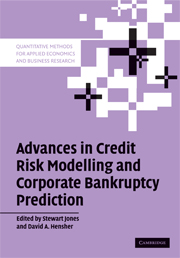Book contents
- Frontmatter
- Contents
- List of figures
- List of tables
- List of contributors
- Introduction
- 1 A statistical model for credit scoring
- 2 Mixed logit and error component models of corporate insolvency and bankruptcy risk
- 3 An evaluation of open- and closed-form distress prediction models: The nested logit and latent class models
- 4 Survival analysis and omitted dividends
- 5 Non-parametric methods for credit risk analysis: Neural networks and recursive partitioning techniques
- 6 Bankruptcy prediction and structural credit risk models
- 7 Default recovery rates and LGD in credit risk modelling and practice: An updated review of the literature and empirical evidence
- 8 Credit derivatives: Current practices and controversies
- 9 Local government distress in Australia: A latent class regression analysis
- 10 A belief-function perspective to credit risk assessments
- Index
- References
10 - A belief-function perspective to credit risk assessments
Published online by Cambridge University Press: 11 June 2010
- Frontmatter
- Contents
- List of figures
- List of tables
- List of contributors
- Introduction
- 1 A statistical model for credit scoring
- 2 Mixed logit and error component models of corporate insolvency and bankruptcy risk
- 3 An evaluation of open- and closed-form distress prediction models: The nested logit and latent class models
- 4 Survival analysis and omitted dividends
- 5 Non-parametric methods for credit risk analysis: Neural networks and recursive partitioning techniques
- 6 Bankruptcy prediction and structural credit risk models
- 7 Default recovery rates and LGD in credit risk modelling and practice: An updated review of the literature and empirical evidence
- 8 Credit derivatives: Current practices and controversies
- 9 Local government distress in Australia: A latent class regression analysis
- 10 A belief-function perspective to credit risk assessments
- Index
- References
Summary
Introduction
Risk assessment in any field is a challenging problem whether it deals with assessing the potential loss of personal properties due to flood, the presence of material misstatements or fraud in the financial statements of a company, or assessing the likelihood of firm survival or loan default. There are two important general concepts related to risk assessment. One deals with the potential loss due to the undesirable event, such as loan default or corporate bankruptcy. The other deals with the uncertainty associated with the event, whether the event will occur or will not occur. There are two kinds of uncertainties. One kind arises purely because of the random nature of the event. For random events, there exist stable frequencies in repeated trials under fixed conditions.
For such random events, one can use the knowledge of the stable frequencies to predict the probability of occurrence of the event. For example, tossing a fair coin is purely a random process with stable frequencies in repeated trials where one would expect to get head 50% of the times and tail 50% of the times. This kind of uncertainty has been the subject of several previous chapters in this volume which has dealt with various statistical approaches to modelling default risk and corporate bankruptcy prediction.
The other kind of uncertainty arises because of the lack of knowledge of the true state of nature where we not only lack the knowledge of a stable frequency, but also we lack the means to specify fully the fixed conditions under which repetitions can be performed (Shafer and Srivastava 1990).
- Type
- Chapter
- Information
- Publisher: Cambridge University PressPrint publication year: 2008
References
- 1
- Cited by



